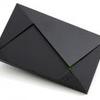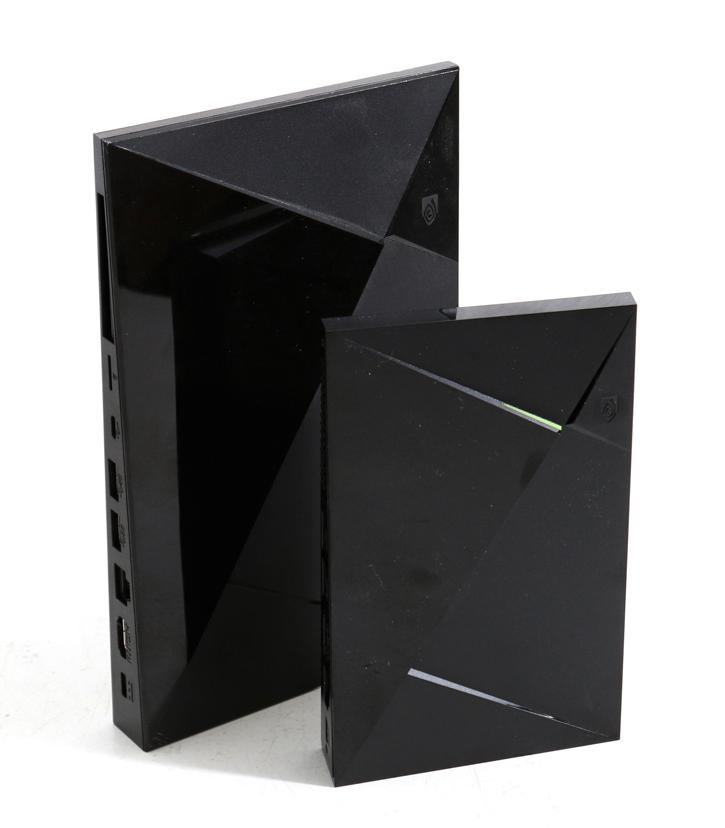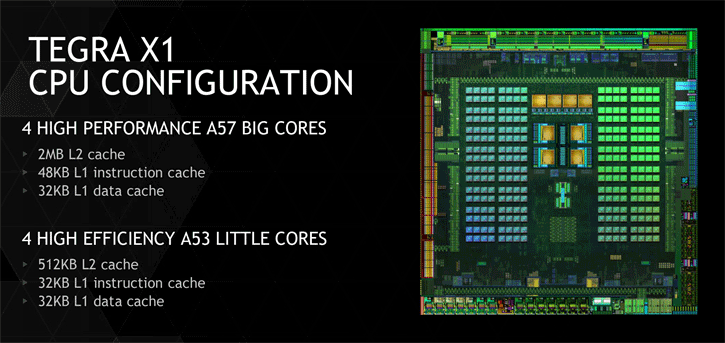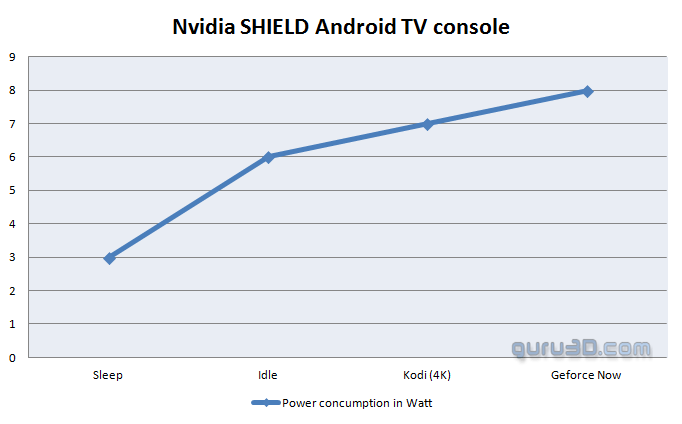Shield Android TV 2017
Shield Android TV 2017
Nvidia's SHIELD Android TV originally was tagged as SHIELD Console, it is an Android TV based set-top box that you can use for all kinds of home entertainment and gaming in your living-room. Initially it was released by Nvidia at the end of May 2015 in the USA and expanded to Europe and Asia in 2016. Slowly but steadily Nvidia decided to improve the design, and that's where we arrive at the 2017 model. have a peek at the next photo.
The new 2017 model 'console' has a form factor change, it is much smaller but harbors the same Tegra X1 SoC the previous model uses. Connections wise the 2017 Shield misses the MicroSD and micro-USB connector the older model has, the rest is there though. So if you have been hoping for faster and better hardware, nope. But you do need to wonder with full support for 4K / Ultra HD, H.264, H.265, HDR, 10-bit and 12-bit colors and stuff like Dolby Atmos and DTS:X why an even more advanced SoC would be needed? Don't forget that this is intended to be a streaming device. Nvidia simply refined and retuned the software and added features. The Shield Android TV 2017 is now the 4th generation "SHIELD" gaming hardware device after the tablets which never grew to be a very popular product series, all based on a Tegra based SoC (System on Chip). That makes the Shield Android TV the first device from Nvidia to get an Android TV ecosystem. Next to that, it allows you to utilize Nvidia's GRID game streaming service in order to play PC games through SHIELD from the cloud.
Full HDR Support
With the 2017 model some new functions are opened up, one of the bigger advantages of the Shield Android TV is its ability to drive and output 4K resolution to a television at 60p over HDMI 2.0, it also supports high definition audio. In the living room Ultra HD and HDR are up and coming rapidly, HDMI 2.0 but also HDCP 2.2 are obviously fully supported. For HDR 10 and 12-bit colors can be supported through Rec, 2020. The HDR standard is tagged under HDR10.
Shield TV offers audio pass-through 7.1 and 5.1 for pretty much any surround sound streams. High-res audio output up to 24-bit/192KHz can be transmitted too. Specs wise Nvidia wasn't shy here either, you'll spot two USB 3.0 ports which can be used for even a keyboard and mouse, but likely you'll use them to charge your remote and controller or use it to connect external storage. There is also a Micro-USB 2.0 port for powering or charging the game controller. Also, if you need a little more storage, can we suggest say a 128GB min USB flash-drive?
Movie playback and multi channel audio
SHIELD Android TV includes features and capabilities to deliver an outstanding home theater experience. SHIELD Android TV further enhances its credentials by including support for Dolby Atmos Pass through, IR control of TVs and receivers. Some of the key features that make SHIELD the best streamer for your home theater setup are:
- Supports hardware acceleration of all the popular video formats including H.264, H.265, VC-1, MPEG-2, WMV9, and VP9
- Supports native playback of video content encoded at 23.976 Hz and 50 Hz (in Europe) for true movie quality viewing experience. Also supports video content encoded at 24 Hz, 25 Hz, 30 Hz, and 59.94 Hz
- Supports AC3, EAC3, Dolby 5.1, Dolby 7.1, DTS-HD, DTS-HD MA, Dolby TrueHD, DTS-X, and Dolby Atmos pass through for an immersive home theater experience with your home theater receiver and surround speakers.
- Supports high resolution 24-bit 192 kHz audio over HDMI and USB for superior audio quality.
- Supports USB-S/PDIF dongles and enables users to connect SHIELD to older sound bars and audio receivers.
- Works flawlessly with media streaming apps such as PLEX and Kodi (XBMC)
- Flawlessly plays back high bit rate Blu-ray movie rips that are stored on your NAS server.
HDMI CEC
The latest builds of Shield fully support HDMI-CEC, very handy as with your TV remote control you can actually steer the Shield. That also works revered for volume control and such. If you TV does not support HDMI CEC, no worries as the new updated controllers also have a built in IR transmitter. HDMI CEC also is very handy in the sense that if you turn off your TV your Shield will power down automatically as well, and yes .. that works reversed as well as the same with other HDMI CEC compatible devices of course.
Tegra X1
The Shield Android TV unit is based upon an 8-core Tegra X1 SoC (64-bit) which is an in-house Nvidia ARM SoC from the Tegra series. It features what is called a BIG little setup that has been arranged as four ARM Cortex-A57 processor cores and then four ARM Cortex-A53 cores, quite plentiful for an Android OS based product. Not just that, it is a huge step forward compared towards the last-gen Tegra K1.
| NVIDIA Tegra GPU Specs Compared | ||
| K1 | X1 | |
| CUDA Cores | 192 | 256 |
| Texture Units | 8 | 16 |
| ROPs | 4 | 16 |
| GPU Clock | 950MHz | 1000MHz |
| Memory Clock | 930MHz (LPDDR3) | 1600MHz (LPDDR4) |
| Memory Bus Width | 64-bit | 64-bit |
| FP16 Peak | 365 GFLOPS | 1024 GFLOPS |
| FP32 Peak | 365 GFLOPS | 512 GFLOPS |
| Architecture | Kepler | Maxwell |
| Manufacturing Process | TSMC 28nm | TSMC 20nm SoC |
The big A57 cores have more L2 cache (2MB) plus slightly bigger instruction and data-caches. The unit houses 256 shader/stream/cuda processors based on an all too familiar Maxwell architecture, the codename for the SoC is GM20B. If you look at the upper screenshot, you can literally count the 256 cores arranged in 32 sets of 8. So albeit it won't be high-end gaming, simple Android games will be plenty fast thanks to this design. Despite what many people think, it's not a 28nm fab but actually is one of the few products fabbed on 20nm, so while 20nm failed for the bigger GPUs, it did work out for the relatively small and simpler Tegra.
- CPU: ARMv8 ARM Cortex-A57 (1.9 Ghz) quad-core + ARM Cortex-A53 quad-core (64-bit).
- GPU: Maxwell-based 256 core GPU
- MPEG-4 HEVC & VP9 encoding/decoding support
- TSMC 20 nm process
- Power consumption less than 10 Watts
As the specs imply, and pretty much all Android TV boxes utilize very little power, the Shield is rated at roughly 10 Watts.
For our measurements we didn't even reach 10 Watts much like the last gen model. In sleep it mode the box consumes 3 Watts (which actually is on the high side for a product in sleep mode). Sitting and waiting in an idle mode roughly 4~5 watts, Kodi 4k movie playback while transferring its data over NAS / Ethernet consumes roughly 7 Watts and GeForce Now game streaming give or take 8 Watts. Once you use the WIFI connection at say 5G add another 2 Watts to these numbers. If you power down the unit; it draws less than 1 Watt. Overall these are normal numbers and in fact similar to the 2015/2016 model.





